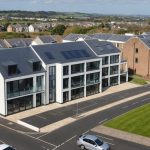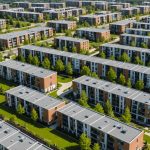Unlocking the Future: Projecting the Lasting Effects of Urban Regeneration on UK Property Investments
Understanding Urban Regeneration and Its Impact
Urban regeneration is a comprehensive process aimed at revitalizing and transforming underutilized or neglected areas within cities. This initiative is not just about physical development but also encompasses social, economic, and environmental aspects. In the UK, urban regeneration has become a pivotal strategy for enhancing the attractiveness and viability of cities, making them more appealing for both residents and investors.
The Role of Urban Regeneration in Property Investment
Urban regeneration projects are designed to create vibrant, sustainable, and desirable cities. For instance, in Salford, the ongoing Phase 2 regeneration is building on the success of earlier developments like MediaCityUK, a £1 billion project that has established Salford as a hub for the creative and digital sectors. This transformation has significantly boosted the area’s appeal for property investors, with average rental yields ranging from 6-7%, far exceeding those in London[1].
Also read : Assessing the Potential of Converting Properties into Holiday Lets in the UK: A Comprehensive Guide
Economic Growth and Job Creation
One of the primary drivers of urban regeneration is economic growth. Cities like Bath and Salford are experiencing significant economic success, which is a magnet for new residents and businesses. In Bath, plans are underway to create 65,000 new jobs, supported by the presence of two universities, the Royal United Hospital, and thriving market towns. Councillor Paul Roper of Bath and North East Somerset highlighted, “Our residents are highly qualified, and unemployment is low,” which underscores the city’s economic vitality[2].
Job Creation and Its Effects on Property Demand
The creation of new jobs is a critical factor in increasing demand for housing and other properties. As more people move to these areas for employment opportunities, the demand for both residential and commercial properties rises. This increased demand can lead to higher property prices and rental yields, making these cities attractive for property investors.
Topic to read : Assessing the Profit Potential: A Guide to Converting UK Residential Properties for Commercial Use
Infrastructure Improvements and Connectivity
Infrastructure improvements are a cornerstone of urban regeneration projects. In Salford, upgrades to the transport network, including enhanced tram services and better connectivity with Manchester, are making the city more desirable for commuters. Similarly, in Bath, the regeneration of the riverfront between Pulteney Bridge and Bath Spa Train Station, known as the Bath Central Riverside project, is set to enhance the usability and safety of the area, making it more appealing to residents and visitors alike[1][2].
How Improved Infrastructure Affects Property Value
Improved infrastructure can significantly boost property values. Here are some key ways in which infrastructure enhancements impact property investment:
- Enhanced Connectivity: Better transport links make areas more accessible, increasing their appeal to potential residents and businesses.
- Increased Safety: Safer environments, such as those achieved through the Bath Central Riverside project, attract more families and young professionals.
- Aesthetic Appeal: Upgraded public spaces and amenities improve the overall quality of life, making areas more desirable.
Sustainability and Social Value
Urban regeneration projects often incorporate sustainability initiatives and focus on adding social value. In Salford, eco-friendly designs and smart city technologies are integral to the Phase 2 regeneration. These initiatives not only attract environmentally conscious investors but also contribute to a better quality of life for residents[1].
The Importance of Sustainability in Property Investment
Sustainability is becoming a key factor in property investment decisions. Here are some reasons why sustainable projects are gaining traction:
- Environmental Benefits: Eco-friendly designs reduce the carbon footprint of properties, aligning with global sustainability goals.
- Cost Savings: Energy-efficient buildings can lead to lower operational costs, making them more attractive to tenants and investors.
- Social Responsibility: Investors are increasingly looking for projects that offer social value, such as affordable housing and community amenities.
Tax Implications and Budget Changes
The 2024 Budget has introduced several changes that affect property investment in the UK. The increase in stamp duty land tax for second homes from 3% to 5% and the rise in Capital Gains Tax rates are significant considerations for investors. These changes may deter some landlords from entering the market, potentially leading to a reduction in available rental properties and subsequent rent increases[3].
Navigating Tax Changes for Optimal Investment
Here are some practical insights on how to navigate the new tax landscape:
- Stamp Duty Adjustments: The increased stamp duty on second homes may make it more costly for landlords to acquire new properties. However, this could also lead to higher rental yields as demand outstrips supply.
- Capital Gains Tax Modifications: The increase in Capital Gains Tax rates will particularly affect high-net-worth individuals and investors. It is crucial to reassess investment strategies and consider the long-term implications of these changes.
Regional Markets vs. London
The UK property market is witnessing a shift in investor focus from London to regional cities. Cities like Salford, Manchester, and Liverpool are becoming increasingly attractive due to their improving infrastructure, more affordable property prices, and higher rental yields. In Salford, for example, average rental yields range from 6-7%, significantly higher than the 2.9-3.5% yields in London[1].
Why Regional Markets Are Gaining Popularity
Here are some reasons why regional markets are gaining traction:
- Affordability: Property prices in regional cities are generally lower than in London, making them more accessible to a broader range of investors.
- Higher Yields: Regional cities often offer higher rental yields, providing better returns on investment.
- Infrastructure Development: Initiatives like the Northern Powerhouse are driving significant investments into the infrastructure of regional cities, enhancing their appeal.
Practical Advice for Property Investors
For those considering property investment in the UK, here are some practical tips to keep in mind:
Research and Due Diligence
- Understand Local Markets: Research the local market trends, including property prices, rental yields, and upcoming regeneration projects.
- Consult Experts: Work with property investment agencies that have local knowledge and expertise.
Diversify Your Portfolio
- Spread Your Investments: Consider investing in multiple locations to mitigate risks and maximize returns.
- Mix of Property Types: Include a mix of residential, commercial, and buy-to-let properties in your portfolio.
Long-Term Perspective
- Focus on Long-Term Growth: Urban regeneration projects often yield long-term benefits. Be patient and focus on the potential for capital appreciation and sustained rental income.
- Stay Informed: Keep abreast of market trends, tax changes, and new developments to make informed investment decisions.
Case Studies: Salford and Bath
Salford: A Model for Urban Regeneration
Salford’s Phase 2 regeneration is a prime example of how urban regeneration can transform a city. Here are some key developments:
- New Residential Projects: Various new housing projects catering to a broad demographic.
- Infrastructure Improvements: Upgrades to the transport network and connectivity with Manchester.
- Sustainability Initiatives: Eco-friendly designs and smart city technologies.
These developments have spurred demand for Salford property investment, making the city an increasingly attractive market for those seeking high-yield investment opportunities[1].
Bath: Regeneration and Economic Growth
Bath is another city benefiting from significant regeneration efforts. Here are some key projects:
- Bath Central Riverside: Renewing the riverfront to enhance usability and safety.
- Bath Quays North: Developing a new city centre district with office space, a hotel, and retail areas.
- High Street Renewal: Improving public squares, street furniture, and market spaces to stimulate the city centre economy[2].
These projects are driving economic growth and making Bath a vibrant and attractive place to live and invest.
Urban regeneration is a powerful tool for transforming cities and enhancing their appeal for property investors. By focusing on economic growth, infrastructure improvements, sustainability, and social value, these projects create vibrant and desirable cities. As the UK property market continues to evolve, with shifts in investor focus towards regional cities and changes in tax policies, it is crucial for investors to stay informed and adapt their strategies accordingly.
For those looking to secure high returns, now is an ideal time to explore property investment opportunities in cities like Salford and Bath. With their ongoing regeneration, these cities offer a promising future for property investors, combining strong rental yields, potential for capital appreciation, and a commitment to sustainability and social value.
Table: Comparing Key Aspects of Salford and Bath Regeneration Projects
| Aspect | Salford | Bath |
|---|---|---|
| Economic Growth | Creation of new jobs in the creative and digital sectors | Creation of 65,000 new jobs in various sectors |
| Infrastructure | Upgrades to transport network, improved connectivity with Manchester | Renewal of riverfront, new city centre district development |
| Sustainability | Eco-friendly designs, smart city technologies | Upgrades to public spaces, climate resilience measures |
| Rental Yields | Average yields range from 6-7% | Attractive rental yields due to high demand |
| Property Prices | More affordable compared to London | Increasing due to high demand and regeneration efforts |
| Regeneration Projects | MediaCityUK expansion, new residential projects | Bath Central Riverside, Bath Quays North, High Street Renewal |
| Social Value | Affordable housing, community amenities | Public square improvements, new street furniture, event spaces |
Detailed Bullet Point List: Benefits of Urban Regeneration for Property Investors
-
Increased Property Values:
-
Regeneration projects often lead to higher property prices due to improved infrastructure and amenities.
-
Enhanced aesthetic appeal and safety of the area can increase property values.
-
Higher Rental Yields:
-
Improved infrastructure and amenities attract more residents, leading to higher demand and thus higher rental yields.
-
Regional cities often offer higher rental yields compared to major cities like London.
-
Capital Appreciation:
-
Long-term growth potential as regeneration projects continue to develop and enhance the area.
-
Increased investment in the area can lead to sustained capital appreciation.
-
Sustainability and Social Value:
-
Eco-friendly designs and smart city technologies attract environmentally conscious investors.
-
Affordable housing and community amenities add social value, making the area more desirable.
-
Economic Growth:
-
Creation of new jobs and economic opportunities increases demand for housing and commercial properties.
-
Strong local economies supported by regeneration efforts make the area more attractive for businesses and residents.
-
Infrastructure Improvements:
-
Better transport links and connectivity enhance the appeal of the area.
-
Upgraded public spaces and amenities improve the quality of life, attracting more residents and businesses.
-
Diversified Investment Opportunities:
-
Mix of residential, commercial, and buy-to-let properties available in regenerated areas.
-
Opportunities for investing in new developments and existing properties with potential for renovation.
-
Tax Considerations:
-
Understanding the impact of tax changes, such as increased stamp duty and Capital Gains Tax, on investment strategies.
-
Potential for higher rental yields to offset increased tax burdens.
By understanding these aspects and how they interplay, property investors can make informed decisions that align with the evolving landscape of the UK property market, ensuring long-term success and high returns on their investments.











